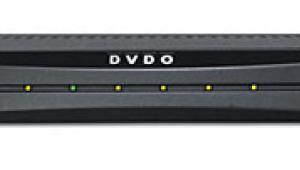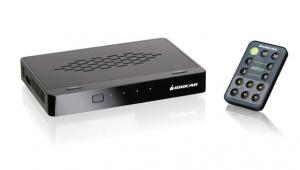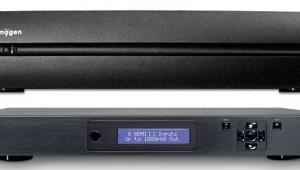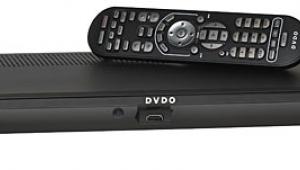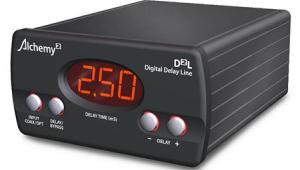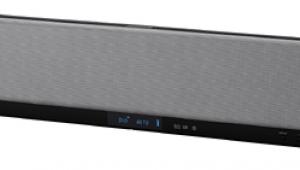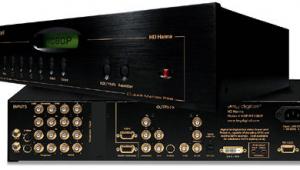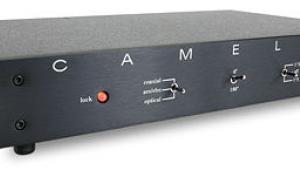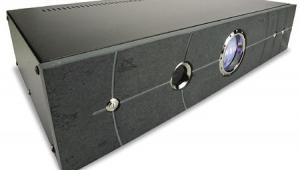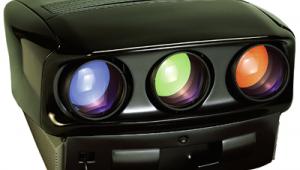Lexicon MC-12 V4: Room EQ Upgrade Kit
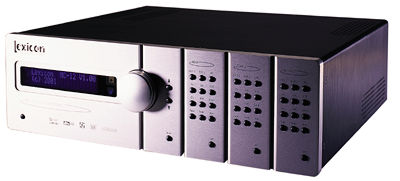
Recent advancements in digital signal-processing (DSP) technology have made it possible for manufacturers such as TacT and Meridian to offer preamplifiers with built-in electronic room correction. Lexicon now joins the growing ranks of DSP-enabled products with their new V4 EQ upgrade kit for their flagship MC-12 AV preamp-processor. It's not the first DSP room-correction product on the market, but the Lexicon system ranks among the easiest to install and use successfully.
A Simple Plan
The MC-12 V4 room-equalization upgrade kit ($2995) consists of a DSP card, Version 4 software on CD-ROM, a demo CD, and written documentation. The DSP card doubles the Lexicon MC-12's DSP capabilities, providing up to 10 output channels with seven parametric filters each. These seven digital equalizers, which treat the frequencies between 19 and 250Hz, are controlled by the processor's software, which looks for the most severe room resonances. The equalizers correct a room's resonant peaks by reducing the output levels at those frequencies. Instead of going for ruler-flat response, the Lexicon system tries to reduce the worst resonances to improve the system's overall clarity and balance.
A separate microphone kit with four AKG C98 omnidirectional microphones, tabletop stands with clips, and instructions ($795) almost complete the small arsenal of tools needed for the upgrade. You also need a Windows-based computer with an RS-232 connection so you can load the V4 software into the MC-12. Fortunately, you don't need the computer after the new software has been installed. Because I'm a Mac guy sans windoze PC, I sent my MC-12 to Lexicon so they could install the software and card. Local Lexicon dealers are also qualified to do this upgrade. And some dealers may be able to loan or rent you a microphone kit if you wish to do the final in-room setup yourself. If you don't anticipate changing your speakers, room, or setup frequently, that will save you the purchase price of the microphones.
After the card and software have been installed, it should take no more than half an hour to arrange the four mikes and do the complete calibration procedure. Unlike DSP room-correction systems that require a computer or sophisticated test equipment as well as a qualified technician to operate them, the Lexicon V4 can run all its necessary tests without a human overseer. In fact, Lexicon's instructions suggest you leave the room during the testing procedure.
The V4 automatically tests and adjusts not only room EQ, but also channel levels and speaker distances. As long as your microphones are properly arranged, the system should give accurate results. The only problem I encountered was with the Revel Performa C32 center speaker, which the V4 software thought was wired out of phase when it wasn't. Fortunately, even when the software detects an out-of-phase speaker, it will still complete all its tests, and give you an error warning so you can check your speaker's wiring.
I tried the V4 test procedure with the Revel Performa, Dunlavy SC-VI, and Genesis 6.1 speaker systems. Except for the out-of-phase false alarm, the automatic setup worked flawlessly with each system. When I compared the V4's results to a manual calibration using a tape measure and a sound-pressure meter, the V4's settings matched almost exactly, and took far less time to complete.
Once you've run the initial setup tests, Lexicon offers several ways to see if the equalization actually makes a difference. You can turn the equalization off, or use it with a Low, Medium, or High amount of correction. Running comparison tests can be amusing at first, but after a while even the most dedicated tweaker will probably settle on one level and be done with it.
A Clean Execution
Even the best mousetrap is useless if you have no rodents to catch. If your home theater system already measures flat before installing a Lexicon V4 EQ system, it will have little positive effect. Yet few rooms are so blessed. Even with the judicious use of absorptive and reflective room-correction products and careful speaker placement, some low-frequency room resonances are almost inevitable. Although my two dedicated home theater rooms were carefully designed for optimal proportions, they still suffer from some measurable low-frequency problems.
The Lexicon V4 worked beautifully in both rooms. All sources, whether music or movies, sounded more neutral and less colored with the EQ on. The only possible problem is that you might not actually prefer the flatter bass response. Many people are so used to hearing bloated, room-augmented bass that, when confronted by correct, linear bass, they feel their systems have been rendered bass-shy. Often, it takes some ear training to adjust to the flatter response.

With the V4 engaged, the explosions in Pearl Harbor had less lower-midrange boom but far more low-frequency thud. On music and movies with upper and midrange bass in the 80–200Hz range but no true low bass below 50Hz, flatter bass response will sound like less bass. But if you listen critically rather than viscerally, you'll hear that the bass is much cleaner and more agile when not augmented by the room singing along.
An interesting side effect of the V4 room-correction system was that I immediately noticed a reduction in the sonic personalities and differences among different speaker systems: The Genesis 6.1 system's timbral balance sounded much closer to the Revel Performa system's more matter-of-fact balance, and the Genesis system lost a bit of its Rabelaisian character. At first I missed that extra bit of sonic mustard, but after a couple of critical listening sessions I realized that the loss of euphony was more than compensated for by the increase in low-level detail and low-frequency agility.
The sonic differences wrought by the V4 on the Dunlavy system in my large home theater room were profound. Low bass was cleaner and quicker, while midbass, though less abundant, had greater harmonic and dynamic precision. Although the V4 extends up to only 250Hz, I still noticed that even the midrange had slightly better clarity and control with the room correction engaged.
Room EQ: The Final Sonic Frontier
I've been a firm believer in using DSP for room correction since I reviewed the Cambridge Signal Technologies SigTech TF 1120 Time Field Acoustic Correction System eight years ago, in the December 1996 issue of Stereophile. But the difficulty with DSP systems has always been with their installation and ease of use. Lexicon's MC-12 V4 system eliminates these problems—almost anyone can achieve a properly set-up configuration with minimal time and effort. How cool is that?
If you already have a Lexicon MC-12, I urge you to install this upgrade—it's worth every penny, and critical listeners will quickly find it indispensable. For anyone contemplating the purchase of a top-rank AV processor, the V4 EQ system raises the MC-12 into the rarefied ranks of those AV processors that can make your home theater sound better than you ever thought possible. Now that I've experienced the MC-12 V4 room-correction system, I find it nearly impossible to imagine living without it. It's that good.
Ups and Downs
Ups
•More neutral, less colored sound
•Automated testing procedure
Downs
•Cost: To date, it's only available in Lexicon's MC-12 flagship pre-pro.
